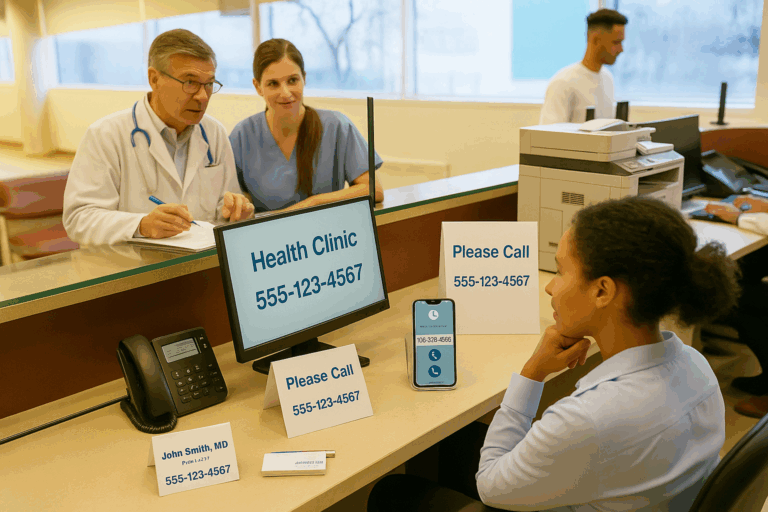Even minor communication errors can compromise patient safety. HIPAA‑compliant VoIP phone systems reduce risk, strengthen privacy, and improve satisfaction for patients and staff.
Key Takeaways
-
Clear, reliable communication reduces errors and costs while improving patient and staff satisfaction.
-
HIPAA compliance for phone systems now spans voice, SMS, voicemail, fax, recordings, and integrations across devices and locations.
-
Cloud-based, HIPAA-compliant VoIP consolidates voice, text, video, and fax with encryption, audit trails, and role-based access.
-
Automated, HIPAA-compliant texting supports patient engagement, boosting loyalty and reducing no‑shows.
-
With the right tools, practices of all sizes can meet requirements without added complexity.
HIPAA’s Security Rule can sometimes feel like paperwork. In reality, it’s a practical framework that requires administrative, physical, and technical safeguards to protect ePHI and support safer, more efficient care.
In 2025, HIPAA affects how your calls, texts, voicemail, and after‑hours routing are designed, secured, and stored. Generic business phone systems struggle to keep pace with regulatory expectations, which is why medical practices should use a HIPAA-compliant communications platform. When communication is secure and seamless, patient care and safety improves. improve. The result: fewer medication errors, faster responses, smoother coordination, and higher overall satisfaction.
HIPAA‑Compliant Phone Systems: the 2025 Definition
Most HIPAA violations tied to phone systems aren’t the result of sophisticated cyberattacks. They occur through everyday communication gaps inside a medical practice, such as forwarding voicemail to a personal device, texting a patient from an unsecured number, misfaxing PHI, or failing to control access to call recordings, which can instantly trigger a reportable breach.
This is why regulators now treat phone systems as part of a practice’s security posture – and why generic platforms often leave compliance gaps.
A healthcare phone system should meet HIPAA’s safeguards for every form of patient communication.
Core requirements to expect include:
- Encryption in transit and at rest for voice, SMS/MMS, voicemail, fax, recordings, and stored files
- Access controls with unique user logins, SSO/2FA support, and role‑based permissions
- Automatic session timeouts to prevent unauthorized access to PHI
- Audit trails that log user activity and support investigations
- Business Associate Agreements (BAAs) with any vendor that creates, receives, transmits, or stores PHI
- Vendor due diligence, meaning healthcare practices should request a BAA and proof of controls, not just accept “HIPAA‑friendly” claims
Operational must‑haves consist of:
- On‑call routing that respects provider preferences (cell, landline, mobile app) and reduces delays
- Secure, two‑way texting to scale personalized outreach, minimize no‑shows/cancellations, and match consumer preference (more than 95 percent of patients prefer texting for healthcare communication)
- E‑fax with confirmation, access controls, and number validation to avoid costly mis‑faxes
- Call recording options are stored on a HIPAA‑compliant infrastructure for training, quality, and documentation
Why Cloud‑Based Communication Systems Matter
For medical practices, outages don’t just interrupt workflow; they interrupt care. When a legacy phone system fails, patients can’t reach the on‑call provider, posing a clinical risk rather than just a technical inconvenience.
A cloud-based voice over Internet Protocol (VoIP) architecture, however, solves this by building redundancy and disaster recovery into the communications framework, so patient access never depends on a single server or location. Cloud communications platforms built for healthcare deliver strong security without expensive hardware:
- No on‑prem upgrades/downtime: VoIP platforms update in the cloud,
- Redundancy and disaster recovery: Geographic failover and shared‑nothing architectures minimize outages.
- Lower total cost: Less hardware to maintain makes scalability and customization easier and more affordable.
- Mobility: Physicians can communicate securely from anywhere, across desk phones, mobile devices, and desktop apps.
- Integration‑ready: Communications platforms integrate with EHRs, practice management systems, billing systems, and more.
According to the United States Department of Health and Human Services (HHS), using HIPAA-compliant cloud storage for patient data is more secure than storing it on paper or a local server. To keep data safe, pair encryption, access control, and audit logging with a signed BAA and clear roles for every individual who handles PHI.
The Compliance Stakes (and How to Avoid Penalties)
Not all HIPAA violations are intentional, but some of the most common violations that have resulted in financial penalties include insufficient ePHI access controls, failure to use encryption or an equivalent measure to safeguard ePHI on portable devices, and the lack of a HIPAA-compliant BAA. Others include snooping on healthcare records, impermissible disclosures, improper disposal of PHI, and failure to perform an organization-side risk analysis.
Hospitals are the most common violators of HIPAA privacy regulations, followed by private practices, outpatient facilities, pharmacies, and health plans. Covered entities responsible for creating, receiving, or transmitting PHI that fail to comply with HIPAA rules and regulations are subject to both civil and criminal fines and penalties.
Criminal HIPAA violation penalties range from a fine of $50,000 and up to a year in prison to $250,000 and up to ten years in prison. Civil penalties range from $100 to $50,000 per violation, with an annual maximum of $25,000 for repeat violations and up to $1.5 million for the most severe cases. Those punitive actions are separate from the damaged reputation and decreased customer trust that a healthcare provider often experiences when PHI is stolen.
Practical safeguards to avoid HIPAA penalties should include:
- Performing an organization‑wide risk analysis and updating it periodically
- Enforcing unique user IDs, MFA, and session timeouts across apps and devices
- Training staff on cybersecurity basics and HIPAA workflows tied to job roles
- Using secure texting and e‑fax
- Centralizing communications on a HIPAA‑compliant VoIP platform with logging and backups
Being OCR Audit-Ready
Like other audits, HHS audits aren’t scheduled on a fixed cadence. Most HIPAA audits occur as a result of a random selection for an audit by the Office for Civil Rights (OCR), a complaint filed with the OCR by an individual against your medical practice, or through a breach occurring and being self-reported to the OCR
Healthcare practices don’t have to spend thousands of dollars to stay compliant with HIPAA regulations or be ready for an OCR audit. However, they should conduct a risk analysis incorporating the following elements as recommended by HHS:
- Scope of the analysis
- Data collection
- Identify and Document Potential Threats and Vulnerabilities
- Assess Current Security Measures
- Determine the Likelihood of Threat Occurrence
- Determine the Potential Impact of Threat Occurrence
- Determine the Level of Risk
- Finalize Documentation
- Periodic Review and Updates to the Risk Assessment
VoIP Features That Matter for HIPAA and Care Quality
Employing the right VoIP platform means better patient handoffs, cleaner documentation, fewer misunderstandings over the phone, and faster escalation when a patient needs attention. In addition to convenience, these systems help clinicians make better, faster decisions by connecting real‑time communication with the data and workflows they use every day.
Key features that support HIPAA compliance and care quality include:
- HD Voice for fewer miscommunications and higher patient satisfaction
- Call queues to handle peak volume and reduce missed calls
- Number portability to avoid disruptions during transitions
- Video visits via the browser for frictionless telehealth
- Cross‑site collaboration with centralized administration across locations
- Julie Higdon, Practice Manager, Eugene Psychological Assessments
How RingRx Delivers HIPAA‑Compliant Communications
At RingRx, patient confidentiality is our top priority. That’s why we designed a HIPAA-compliant VoIP phone system with integrated voice, fax, and text capabilities that enables patients to connect with healthcare providers and receive timely care.
Our secure, cloud-based platform was built with strict security standards for modern healthcare organizations. It’s equipped with industry-leading privacy and security features that enable you to communicate safely and securely with patients and staff across all devices.
Our cloud-based platform offers:
- Secure, two‑way texting for staff and patients, with automated reminders and targeted campaigns
- On‑call management with profiles and schedules, so after‑hours calls reach the right provider
- Call recording on HIPAA‑compliant servers to support quality, training, and documentation
- Web‑based and mobile e‑fax for faster document transfer and fewer errors
- Mobile app availability that allows physicians and their staff to communicate from anywhere without exposing personal numbers
Our HIPAA-compliant phone system can transform your practice’s communication one call at a time:
- Start your free trial
- Schedule a demo
- Review pricing plans




